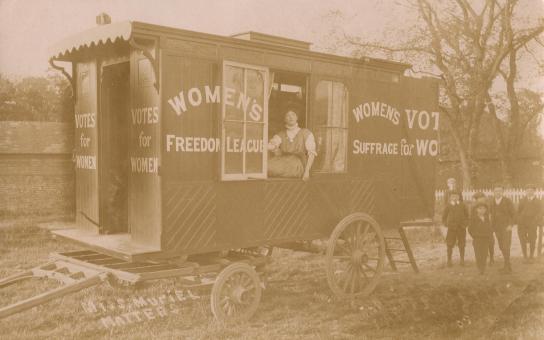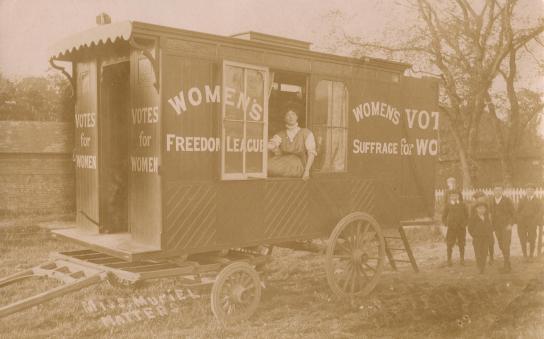Greenwich100 researcher Lynne Dixon tells the inspiring story of the arrival of the women’s suffrage pilgrimage at Blackheath in 1913.
It is July 1913. A dry cool morning on Blackheath. Imagine a group of women on the heath near the tea hut dressed for walking, wearing sashes and carrying banners; an array of scarlet, white and green.
This is part of the Women’s Suffrage Pilgrimage, the Kentish contingent to be exact, formed of two branches which had started at Margate and Sandwich, joining at Tonbridge. It is the morning of Friday 26th July, the day before the national rally in Hyde Park which will bring together women suffragists from across the country. These women – all members of the National Union of Women’s Suffrage Societies (NUWSS) – had been organised in six main marches, the ones from the north having started out in mid June.
In spite of the fact that they were marching as suffragists – the law-abiding and non-militant part of the women’s suffrage movement – some had faced verbal and even physical abuse on the way (Robinson, 2018). Fortunately, the Kent marchers had been relatively unaffected as they marched from Sevenoaks.
Twenty two Kent pilgrims had arrived at Burnt Ash Road, Lee, on the previous day and had formed into a procession with the Blackheath branch of the NUWSS. With their banners unfurled – ‘“Home makers demand vote”, “Law abiding women”, “Joan of Arc”, and the like’ (The Mercury) – the forty or so women were accompanied by the Stepney Borough Band. They marched towards Whitfield Mount on Blackheath – a popular place for local suffragist meetings – where two platforms had been set up, and held an open-air meeting. After the meeting the pilgrims would have stayed overnight in cheap lodging houses or with local society members.
The pilgrims and their supporters set off the following day down Blackheath Hill, through Deptford Broadway and on to New Cross Gate, which they reached by noon. At the foot of Pepys Road they gathered for another meeting and this time we know the name of the two speakers. One was Muriel Matters who had been involved in the movement since her arrival in England from Australia in 1905. By 1913 Matters had already engaged in high profile activities for the cause, including chaining herself to the grille in the women’s gallery above the House of Commons; distributing leaflets from an airship across London, and travelling through Kent and Sussex in a caravan on a Women’s Freedom League speaking tour (Crawford, 2001).
Muriel Matters in Guilford, Surrey in 1908 during a Women’s Freedom League caravan tour
(The Women’s Library Collection, LSE Library). The use of caravans was also a feature of the
1913 Pilgrimage although apparently not in Kent.
As the pilgrims continued on their way for the next even larger gathering at the King’s Hall, Elephant and Castle, they were joined by band of the Amalgamated Society of Railway Workers. They must have garnered much attention.
The final destination was a wonderful gathering of about fifty thousand people – at Hyde Park on the afternoon of the Saturday. There were nineteen platforms arrayed in the park with rousing speeches, including one by the NUWSS President Millicent Garrett Fawcett.
The Kent pilgrims and their supporters contributed to making the 1913 Women’s Suffrage Pilgrimage a great success for the NUWSS and it strengthened the hands of the suffragists in their ongoing negotiations with Asquith’s government.
References
Crawford, E (2001) The Women’s Suffrage Movement: A Reference Guide 1866 – 1928 (Routledge, London)
Robinson, J (2018) Hearts and Minds: The Untold Story of the Great Pilgrimage and How Women Won the Vote (Doubleday, London)
Information about the local march obtained from local newspapers at Greenwich Heritage Centre:
Kentish Mercury July 25th 1913
The Pioneer (Woolwich) 25th July 1913
Kentish Independent 1st August 1913



I found the details fascinating and was especially taken with the fact that the suffragists used caravans on their speaking tours.
LikeLike
I too loved the image of the caravans – and also of leaflets fluttering down from an airship. The vision of them marching must have been wonderful – can we recapture some of the same spirit today.
LikeLike